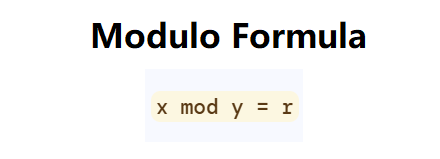 Home
Home
 Back
Back

Definition: This calculator computes the remainder \( r \) of the division of a number \( x \) by another number \( y \), expressed as \( x \mod y = r \). It uses the floored division approach, ensuring the remainder is non-negative even for negative or decimal inputs.
Purpose: It helps users quickly find the remainder of a division, which is useful in modular arithmetic, programming, and applications like cryptography, checksum calculations, and handling decimal-based divisions.
The modulo operation computes the remainder of the division of \( x \) by \( y \):
Steps:
The modulo operation is important for:
Example 1 (Decimal Numbers): Calculate the remainder of 25.5 divided by 4.2:
Example 2 (Negative Dividend): Calculate the remainder of -9.3 divided by 4.1:
Q: Why must the divisor be non-zero?
A: Division by zero is undefined in mathematics, so the divisor cannot be zero.
Q: How does the calculator handle negative numbers?
A: The calculator uses floored division, ensuring the remainder is non-negative. For example, \( -9.3 \mod 4.1 \approx 2.9 \).
Q: Why does the result appear in scientific notation?
A: If the result is less than 0.001 or greater than 100,000, it is displayed in scientific notation for readability; otherwise, it shows 4 decimal places.
Q: Can I use decimal numbers?
A: Yes, the calculator supports decimal inputs for both dividend and divisor, and the remainder can also be a decimal.